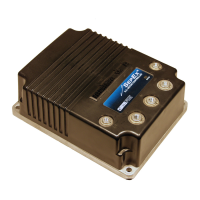Curtis 1244 Manual, Rev. E
A-11
APPENDIX A: GLOSSARY
Throttle map
e throttle map parameter determines the controller’s static throttle map, ad-
justing the throttle characteristics to suit your specific application and enhance
your vehicle’s performance. e throttle map parameter modifies the controller’s
PWM output relative to the requested throttle amount. e throttle map is a
MultiMode™ parameter—see Section 3, page 34.
Throttle max
e throttle max parameter allows accommodation of throttles that do not
provide the standard full range of voltage or resistance variation at the throttle
input. Reducing the throttle max parameter value allows full controller output
with a throttle input less than that specified in Table 1 (page 10). e throttle
max parameter can be programmed to fit your specific vehicle’s requirements—see
Section 3, pages 32–33, and Section 6, page 56.
Throttle types
e 1244 controller accepts a variety of throttle inputs, through various combi-
nations of its three throttle input pins. e most commonly used single-ended
and wigwag throttles (5kΩ–0 and 0–5kΩ pots, 3-wire pots, 0-5V throttles,
and the Curtis ET-XXX electronic throttle) can be used simply by selecting the
appropriate throttle type in the programmer’s Program Menu—see Section3,
page 29. e controller can also be specified to receive throttle signals from a
CAN-based communications system—see Section 4, page 51.
Tuning
e 1244 controller provides a variety of programmable parameters to assist in
tuning the vehicle to meet the customer’s needs. Section 6: Vehicle Performance
Adjustment presents information and procedures for tuning specific operating
characteristics on any vehicle.
Undertemperature
When the controller is operating at less than -25°C, the drive current limit is cut
back to approximately one-half its rated value. e controller will warm itself
at this reduced current and when its internal temperature rises above -25°C,
full current will become available.

